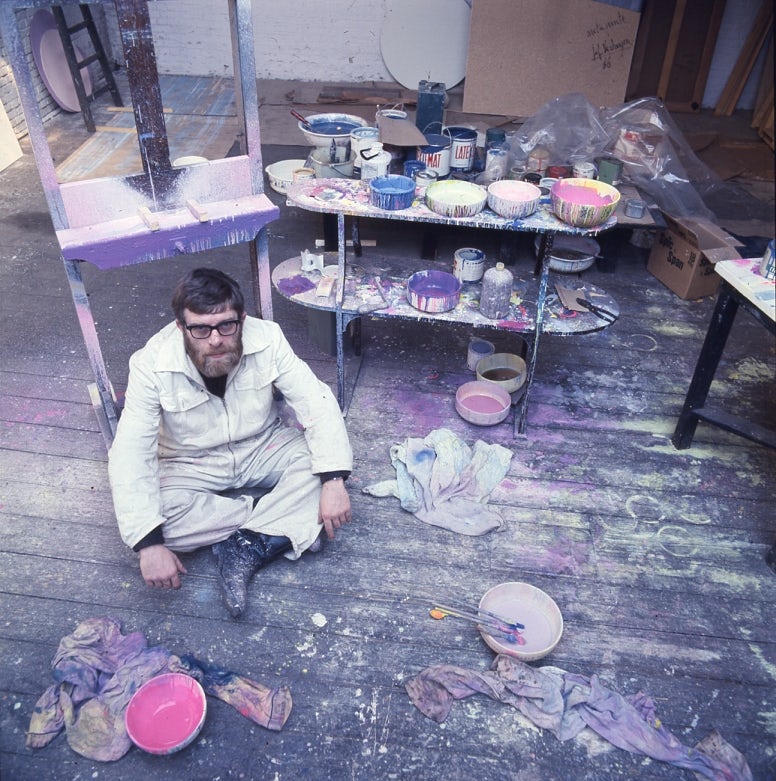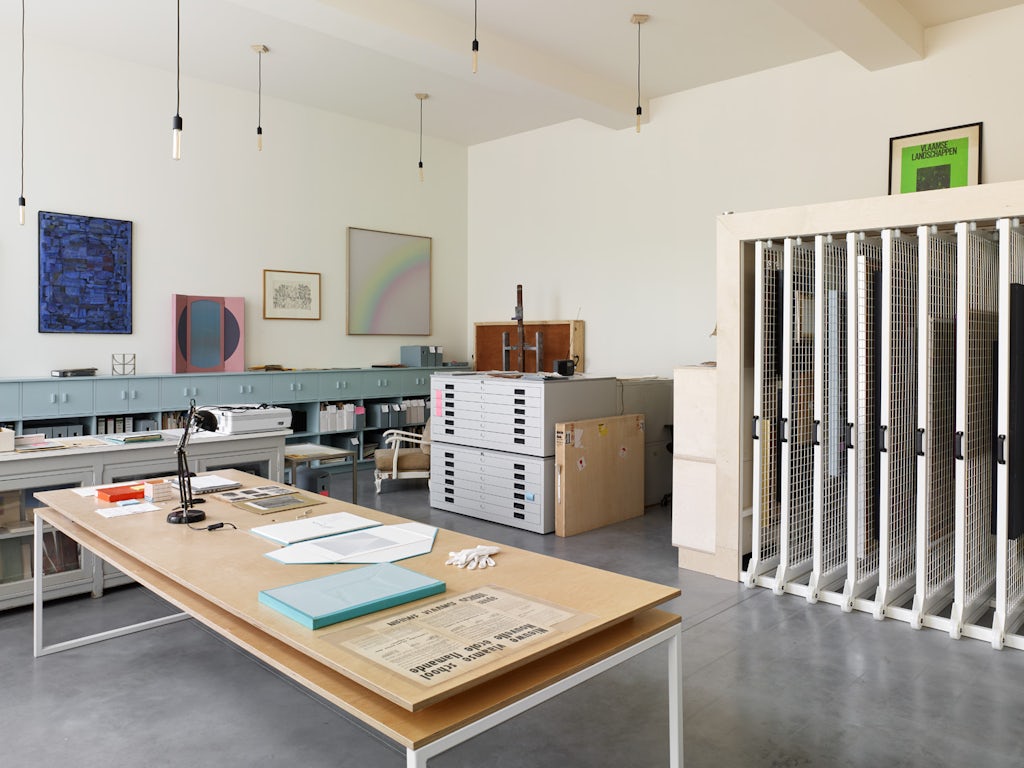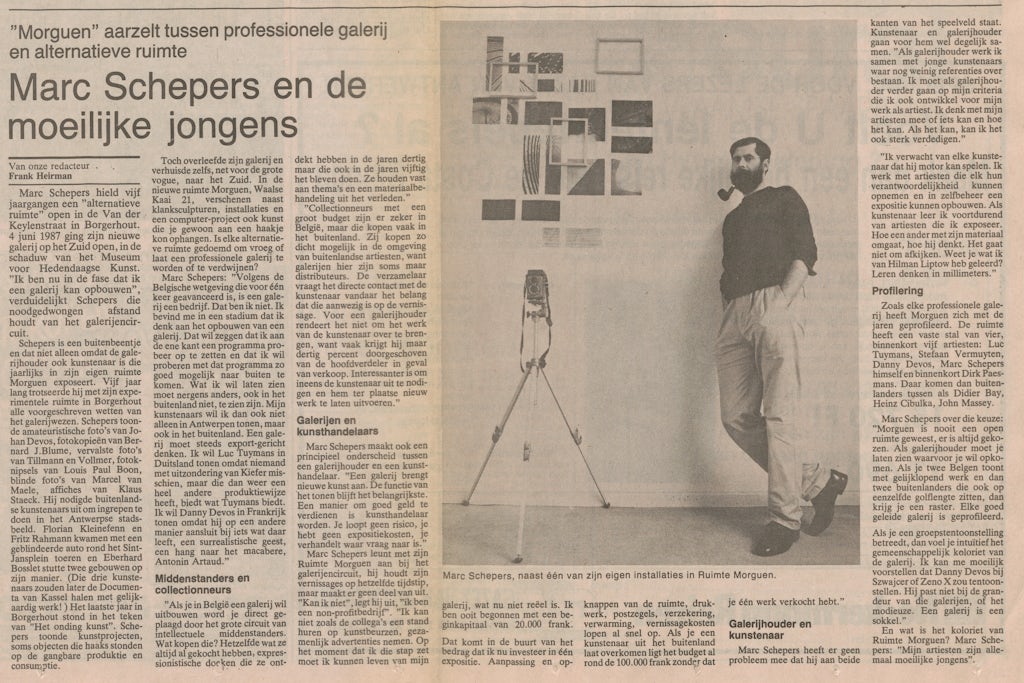Research Trajectory: Jef Verheyen

Portrait of Jef Verheyen by Lothar Wolleh © Lothar Wolleh Estate, Berlin. Courtesy Jef Verheyen Archive. Scan CKV / M HKA.
Bringing dead letters back to life
The CKV shares expertise in the field of visual art archives and legacies. This pilot project around Jef Verheyen (1932-1984) is an example trajectory that focuses on the development of a (digital) catalogue raisonné. To this end, CKV works together with the Jef Verheyen Archive to prepare the disclosure of the Belgian artist’s oeuvre and archive material, thereby aided by M HKA’s Ensembles database.
The research project was started as a multi-year trajectory. It consists of three major phases.
The first phase focuses on drawing up a basic inventory of the oeuvre. In concrete terms, this means that about 800 works of art were registered in Ensembles, using basic criteria such as: year of production, material, dimensions, inscriptions, provenance, exhibitions, publications, photos. Due to the nature of Verheyen’s work, this digital inventory was divided into categories related to medium (canvas, paper, ceramics, sculpture), periodisation (ranging from the 1950s to the 1980s), collections (public, private) or genesis: collaborations, works shared with other artists or authors, etc. The artworks were registered according to first-hand archival documents such as lists and notes written by the artist himself – yet exhibition catalogues, monographs, public collections and auction reports too were fed into the database.
Main aim of the second phase is the digitisation, input and description of all archive material. The database has already been enriched with more than one thousand archival documents that the artist left behind. These are first sorted, grouped, cleaned and packed acid-free. Archive documents are then professionally scanned, entered into the existing database, and described one by one. Here too, categories are used to structure the quantity of items. Main series are notebooks and sketchbooks, manuscripts of Verheyen’s theoretical essays (e.g. Essentialisme), (travel) diaries, correspondence, photos, literary archive, exhibitions plans, publication proofs, texts about Verheyen, press cuttings, posters, publications and official records.
Finally, in a third phase following the archival process, Verheyen’s work is placed in a broader historical context. The latter takes form through the interpretation of the various trajectories he took during his career, such as the focus on ceramics, his manifesto ‘Pour une peinture non plastique’ [For a Non-Visual Painting], the foundation of the Nieuwe Vlaamse School [New Flemish School], Verheyen’s position at Filmgroep 58, or the organisation of the exhibition Integratie 64. After all, by using the database, it is possible to link important themes from the artist’s life and work. In this way, it is much easier to focus on certain partial aspects, on phases, exhibitions, collaborations or artist movements that are part of Verheyen’s artistic universe.

Jef Verheyen Archive © Kristien Daem, Rob
Below are some examples to illustrate certain peculiarities that emerge during this two-part project, that focuses on the archive and the oeuvre.
Dialogue
Jef Verheyen’s project learns us the advantages of a dialogue between oeuvre and archive. Through the description and decipherment, the archive material was again associated with works of art, exhibitions, themes, sales, travel, networks and collaborations with museums, galleries or other artists. Many of the letters and individual notes provide insight into Verheyen’s aesthetics and philosophy, and the reconstruction of the archive thus forms an important basis for questions that external researchers, curators and collectors might have. In this way, exhibitions are for example reconstructed – not only through a correct view of the works present, but also starting from all preparatory notes, correspondences, photos and publications.
In other words, the Ensembles database is used as a tool to connect archive and oeuvre, to revive them. The database makes it possible to build up a clear structure of different clusters that can also be linked to each other. These clusters or ‘ensembles’ are flexible in content and can be works of art, documents, photos, but also projects, exhibitions and events.
Dynamics
Partly due to the visibility of our research, unknown archive material or lost works are regularly identified. Jef Verheyen’s oeuvre overview is therefore a dynamic work in progress, rather than a closed oeuvre catalogue. Owners of work or archival materials can register by filling out a form on the website. New works may also sporadically pop up through other channels, as well as via new archive material that comes to the fore. This open working method is beneficial in remedying a common shortcoming, namely that new information emerges shortly after the publication of a paper catalogue raisonné – information that was not included in the oeuvre’s overview. This is typical for any oeuvre that has changed hands and is no longer in the possession of the artist himself, the heirs, or the first owners.
Private vs Public
When making the Jef Verheyen Archive accessible in Ensembles, different reading and writing rights, including restricted access, are used. Any form of information can be made publicly visible, partially visible or invisible. This offers the advantage of opening up archival documents relating to Verheyen’s private life, without making them publicly visible. This also applies, for example, to data related to origin or provenance. The various reading and writing rights are determined in mutual consultation with the estate of Jef Verheyen. The aim is to arrive at a public digital database, in which selected information will be made publicly available in a standard way, whilst other information can be requested (for example by researchers) via the archive manager.
Paraphernalia
In addition to the usual items in the archive mentioned above, the Jef Verheyen Archive also contains Verheyen’s personal library and various paraphernalia. Examples are the preserved objects from his various studios, or the collection of artefacts that Verheyen at the time received from befriended artists and that are often marked with personal dedications. The artist also left behind a liber amicorum or ‘book of friends’, which is a valuable document that shows an artist’s artistic and literary circle at a glance. Verheyen’s oeuvre includes niche works too, such as collaborations with other artists, writers or friends. These achievements from the ‘periphery’ complete the current art historical perception of Jef Verheyen.
(ADT)


